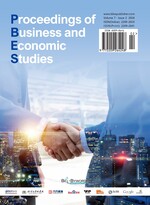Abstract
This study investigated the impact of China’s monetary policy on both the money market and stock markets, assuming that non-policy variables would not respond contemporaneously to changes in policy variables. Monetary policy adjustments are swiftly observed in money markets and gradually extend to the stock market. The study examined the effects of monetary policy shocks using three primary instruments: interest rate policy, reserve requirement ratio, and open market operations. Monthly data from 2007 to 2013 were analyzed using vector error correction (VEC) models. The findings suggest a likely presence of long-lasting and stable relationships among monetary policy, the money market, and stock markets. This research holds practical implications for Chinese policymakers, particularly in managing the challenges associated with fluctuation risks linked to high foreign exchange reserves, aiming to achieve autonomy in monetary policy and formulate effective monetary strategies to stimulate economic growth.
References
Sellin P, 2001, Monetary Policy and the Stock Market: Theory and Empirical Evidence. Journal of Economic Surveys, 15(4): 491–541. https://doi.org/10.1111/1467-6419.00147
Mishkin FS, 2013, The Economics of Money, Banking and Financial Markets (10th ed). Pearson Education, New York.
Chen SS, 2007, Does Monetary Policy Have Asymmetric Effects on Stock Returns? Journal of Money, Credit and Banking, 39(2–3): 667–688. https://doi.org/10.1111/j.0022-2879.2007.00040.x
Doh T, Connolly M, 2013, Has the Effect of Monetary Policy Announcements on Asset Prices Changed? Economic Review-Federal Reserve Bank of Kansas City, QIII: 31–65.
Podobnik B, Horvati? D, Kenett DY, et al., 2012, The Competitiveness Versus the Wealth of a Country. Scientific Reports, 2(1): 678. https://doi.org/10.1038/srep00678
Sun R, 2013, Does Monetary Policy Matter in China? A Narrative Approach. China Economic Review, 26: 56–74. https://doi.org/10.1016/j.chieco.2013.03.003
Tang Y, Luo Y, Xiong J, et al., 2013, Impact of Monetary Policy Changes on the Chinese Monetary and Stock Markets. Physica A: Statistical Mechanics and Its Applications, 392(19): 4435–4449. https://doi.org/10.1016/j.physa.2013.05.023
Dickinson D, Jia L, 2007, The Real Effects of Monetary Policy in China: An Empirical Analysis. China Economic Review, 18(1): 87–111. https://doi.org/10.1016/j.chieco.2005.11.002
Taylor JB, 1995, The Monetary Transmission Mechanism: An Empirical Framework. Journal of Economic Perspectives, 9(4): 11–26. https://doi.org/10.1257/jep.9.4.11
Boivin J, Kiley MT, Mishkin FS, 2010, How has the Monetary Transmission Mechanism Evolved Over Time? in Handbook of Monetary Economic (Vol. 3). Elsevier, Amsterdam 369–422. https://doi.org/10.1016/B978-0-444-53238-1.00008-9
Gray S, Talbot N, 2006, Monetary Operations, in Handbooks in Central Banking. Bank of England Handbook, England, 1–80.
Schaechter A, 2001, Implementation of Monetary Policy and the Central Bank’s Balance Sheet. IMF Working Paper No. 01/149. https://ssrn.com/abstract=879959
Yongding Y, 2014, Macroeconomic Management of the Chinese Economy Since the 1990s, in Routledge Handbook of the Chinese Economy. Routledge, London, 138–156. https://doi.org/10.4324/9781315767475
Helfand SM, Sielawa VH, Singhania D, 2019, A Matter of Time: An Impact Evaluation of the Brazilian National Land Credit Program. Journal of Development Economics, 141: 102361. https://doi.org/10.1016/j.jdeveco.2019.06.004
Rocheteau G, Wright R, Xiao SX, 2018, Open Market Operations. Journal of Monetary Economics, 98: 114–128. https://doi.org/10.1016/j.jmoneco.2018.04.012
Xi N, Ding N, Wang Y, 2005, How Required Reserve Ratio Affects Distribution and Velocity of Money. Physica A: Statistical Mechanics and its Applications, 357(3): 543–555. https://doi.org/10.1016/j.physa.2005.04.014
Hu X, Zhu B, Zhou H, 2024, Impact of Low-Carbon Monetary Policies on Climate-Related Systemic Risk: Evidence from China. Journal of Cleaner Production, 434: 139858. https://doi.org/10.1016/j.jclepro.2023.139858
Wu S, Khan M, Legido-Quigley H, 2020, What Steps Can Researchers Take to Increase Research Uptake by Policymakers? A Case Study in China. Health Policy and Planning, 35(6): 665–675. https://doi.org/10.1093/heapol/czaa025
Chen J, Xu L, 2023, Do Exchange-Traded Fund Activities Destabilize the Stock Market? Evidence from the China Securities Index 300 Stocks. Economic Modelling, 127: 106450. https://doi.org/10.1016/j.econmod.2023.106450
Kong L, Zhou X, Duan M, et al., 2022, A Dataset of a Proxy Variable for the Poultry Trade Flows in China. Scientific Data, 9(1): 690. https://doi.org/10.1038/s41597-022-01793-6
